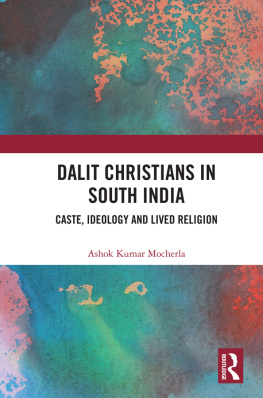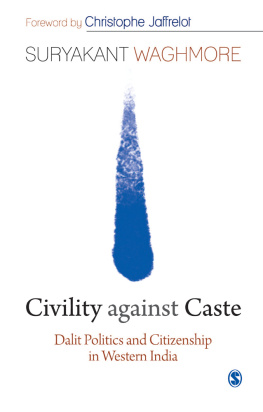The Persistence of Caste: The Khairlanji Murders and India's Hidden Apartheid
Preface
Anand Teltumbdes analysis of the public, ritualistic massacre of a dalit family in 21st century India exposes the gangrenous heart of our society. It contextualizes the massacre and describes the manner in which the social, political and state machinery, the police, the mass media and the judiciary all collude to first create the climate for such bestiality, and then cover it up. This is not a book about the last days of relict feudalism, but a book about what modernity means in India. It discusses one of the most important issues in contemporary India.
A rundhati R oy , author of The God of Small Things
This book is finally the perfect demonstration that the caste system of India is the best tool to perpetuate divisions among the popular classes to the benefit of the rulers, thus annihilating in fact the efficiency of their struggles against exploitation and oppression. Capitalist modernization is not gradually reducing that reality but on the opposite aggravating its violence. This pattern of modernization permits segments of the peasant shudras to accede to better conditions through the over-exploitation of the dalits. The Indian Left must face this major challenge. It must have the courage to move into struggles for the complete abolition of caste system, no less. This is the prerequisite for the eventual emerging of a united front of the exploited classes, the very first condition for the coming to reality of any authentic popular democratic alternative for social progress. This book provides a wonderful analysis towards this understanding. I would hope to see it read by every Indian activist and also foreigners who do not see how odious the caste system is.
Samir Amin , Director of Third World Forum, Dakar, Senegal
Teltumbde has created a solid corpus of work that bears witness to the degradation of Indian democracy, and to the capacity of Indian socialism. Indias revolution... is sharpened on the anvil of Teltumbdes thoughts.
Vijay Prashad , author of The Darker Nations: A Peoples History of the Third World
Introduction Caste: A Historical Outline
Turn in any direction you like, caste is the monster that crosses your path. You cannot have political reform, you cannot have economic reform, unless you kill this monster.
B.R. Ambedkar
Indias caste system has always bewildered the world. Much has been written about it; more still awaits the writing. Many scholars have tried to fathom its origins but have ultimately contributed only further conjecture. Many have tried to define it but have failed to capture its complexity. For most, it was a relic of Indian feudalism which, it was thought, would disappear once capitalism was established. Writing in 1853, the year the railways were introduced in India, Karl Marx prophesied that the new mechanized transportation system would catalyse the collapse of caste. Today, India has the worlds second largest railway network and has created, since Independence, a sizeable infrastructure for capitalist industry. But all that could not kill caste, which proved more than capable of adjusting to the new reality. After Independence in 1947, rural India was transformed through a modernizing project that included, among other things, land reforms and the capital-intensive technologies of the Green Revolution in agriculture. Capitalist production relations came to the villages and seemed to shake the caste structure to its roots - but caste survived nonetheless.
Since the mid-1980s, a now neoliberal India has taken remarkable strides towards globalizing its economy and, with an impressive recent growth record, has increasingly been projecting itself as an emerging superpower. The world is dazzled by its success. Caste was expected to fall away under pressure of the global order. That has not happened. On the contrary, it appears to have grown far more vicious, if caste atrocities are taken as a proxy measure.
Indeed, caste has showed an amazing resilience. It has survived feudalism, capitalist industrialization, a republican Constitution, and today, despite all denial, is well alive under neoliberal globalization.
Caste and the Indian Diaspora
In the globalized, transnational world of the twenty-first century, the need for an accurate understanding of this vicious institution can never be over-emphasized. A call for international recognition of caste as a racist violation of human rights has been addressed to the world community, not once but twice in the last decade - it went ignored in both the resolution adopted by the 2001 World Conference against Racism, Racial Discrimination, Xenophobia and Related Intolerance held in Durban and in the outcome document of the Review Conference held in 2009. The United Nations High Commissioner for Human Rights, Navi Pillay, declared in 2009 that the time has come to eradicate the shameful concept of caste, and that the international community should come together to support these efforts as it did when it helped put an end to apartheid. 1
It is such international pressure that led to the introduction of the Equality Bill in the UK parliament in March 2010, a bill that outlaws discrimination based on caste and is likely to become the first piece of legislation in the world to treat caste as an aspect of race. In 2009, the UKs Anti Caste Discrimination Alliance (ACDA) conducted a study that showed how 58 percent of the 300 people surveyed had been discriminated against because of their caste, while 79 percent said they did not think the police would understand if they tried to report a caste-related hate crime. 2 However, the Indian government has always managed to successfully oppose the terming of caste-based discrimination as racism - this would perhaps have been different had there been a more widespread comprehension of the issues at stake.
Caste is neither so country-specific nor, from a Western perspective, so distant an issue as may be thought. It has been carried far beyond the borders of the subcontinent with the spread of the Indian diaspora. 3 Wherever Indians have gone, it has followed them; wherever they have settled, caste has also established itself. Some scholars hold that it is Hinduism - an ethnic religion, unlike other major faiths - that is a key element in defining the Indian diaspora. 4 Arguably, this key element can be discerned as caste, which other scholars unequivocally name as providing a more enduring marker of diaspora identity than religion. 5 The important thing to note is that caste in the diaspora is not confined to intra-community relations alone; it notionally extends, in the minds of its practitioners, beyond their boundaries to incorporate the population native to their adoptive place of domicile.
The manifestation of caste within the diaspora depends upon the position occupied by the dispersed groups within the hierarchic caste continuum. Where dispersion happened at its lowest band, as in South Africa, Malaysia and other countries where those of Indian origin are largely descended from colonial indentured labour, caste manifests least as compared to places that received dispersion at higher strata. In South Africa or Malaysia, for example, caste identities are not dominant - among other reasons because their maintenance was of little value to the migrants to these places, drawn as they were from the lower ranks of the caste hierarchy. 6 That, however, did not prevent the small segment of higher caste migrants from keeping their distance from the lowly labouring classes, diasporic as well as black. In East and West Africa, Indian trading castes, settled in these parts for over a century, have fastidiously preserved their caste existence, even to the extent of recreating the abominable practice of so-called untouchability - in the absence of actual untouchables (or dalits as they are prevalently called in India), 7 this degraded status has been accorded to the native black population. A similar development is observable in Europe, where, during the post-World War II reconstruction effort, many dalits migrated and settled as workers. In America and Canada, South Asian immigrants from both dalit and nondalit backgrounds mostly arrived in pursuit of higher education and settled later in modern professions; these segments are, by and large, more sophisticated than those in Africa and Europe, yet the problem of caste continues to manifest itself among them, even if in subtler terms.











